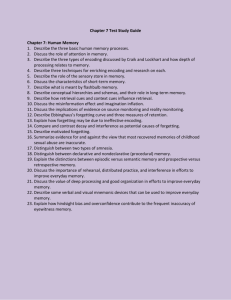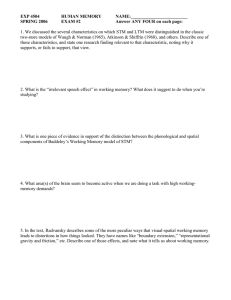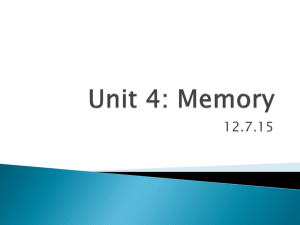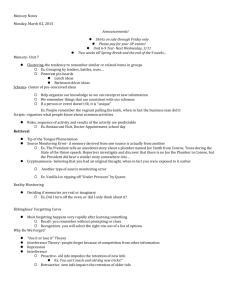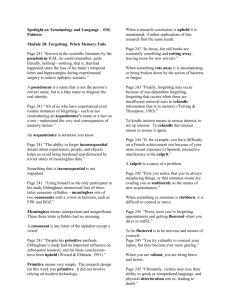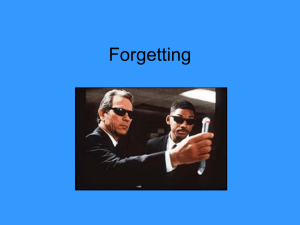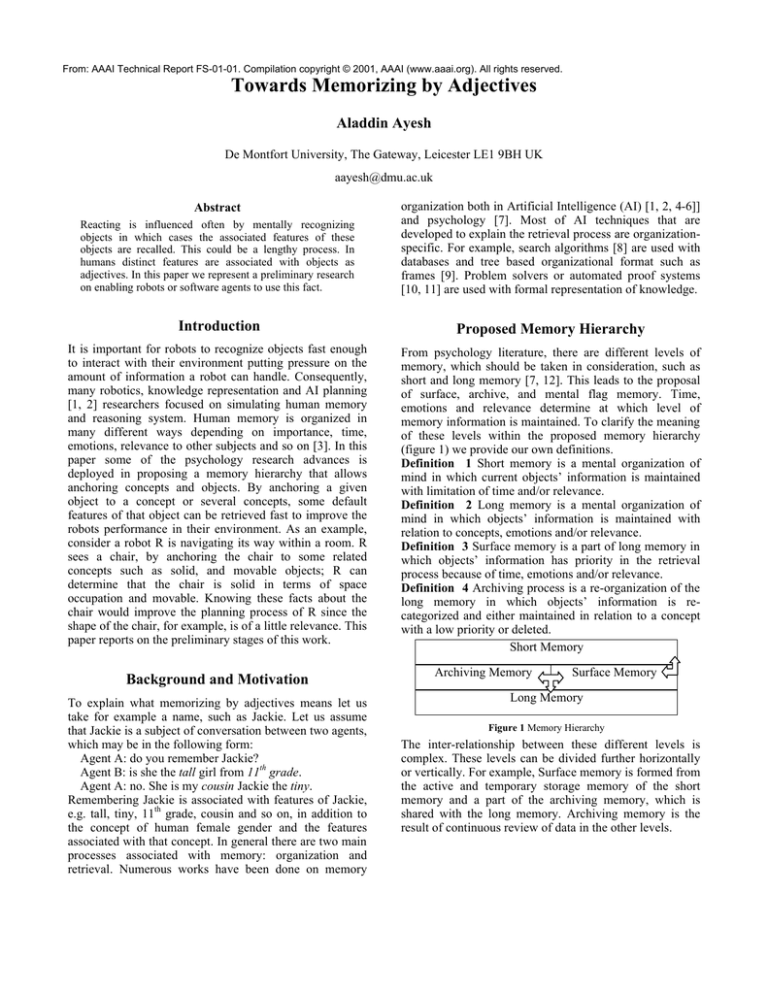
From: AAAI Technical Report FS-01-01. Compilation copyright © 2001, AAAI (www.aaai.org). All rights reserved.
Towards Memorizing by Adjectives
Aladdin Ayesh
De Montfort University, The Gateway, Leicester LE1 9BH UK
aayesh@dmu.ac.uk
Reacting is influenced often by mentally recognizing
objects in which cases the associated features of these
objects are recalled. This could be a lengthy process. In
humans distinct features are associated with objects as
adjectives. In this paper we represent a preliminary research
on enabling robots or software agents to use this fact.
organization both in Artificial Intelligence (AI) [1, 2, 4-6]]
and psychology [7]. Most of AI techniques that are
developed to explain the retrieval process are organizationspecific. For example, search algorithms [8] are used with
databases and tree based organizational format such as
frames [9]. Problem solvers or automated proof systems
[10, 11] are used with formal representation of knowledge.
Introduction
Proposed Memory Hierarchy
It is important for robots to recognize objects fast enough
to interact with their environment putting pressure on the
amount of information a robot can handle. Consequently,
many robotics, knowledge representation and AI planning
[1, 2] researchers focused on simulating human memory
and reasoning system. Human memory is organized in
many different ways depending on importance, time,
emotions, relevance to other subjects and so on [3]. In this
paper some of the psychology research advances is
deployed in proposing a memory hierarchy that allows
anchoring concepts and objects. By anchoring a given
object to a concept or several concepts, some default
features of that object can be retrieved fast to improve the
robots performance in their environment. As an example,
consider a robot R is navigating its way within a room. R
sees a chair, by anchoring the chair to some related
concepts such as solid, and movable objects; R can
determine that the chair is solid in terms of space
occupation and movable. Knowing these facts about the
chair would improve the planning process of R since the
shape of the chair, for example, is of a little relevance. This
paper reports on the preliminary stages of this work.
From psychology literature, there are different levels of
memory, which should be taken in consideration, such as
short and long memory [7, 12]. This leads to the proposal
of surface, archive, and mental flag memory. Time,
emotions and relevance determine at which level of
memory information is maintained. To clarify the meaning
of these levels within the proposed memory hierarchy
(figure 1) we provide our own definitions.
Definition 1 Short memory is a mental organization of
mind in which current objects’ information is maintained
with limitation of time and/or relevance.
Definition 2 Long memory is a mental organization of
mind in which objects’ information is maintained with
relation to concepts, emotions and/or relevance.
Definition 3 Surface memory is a part of long memory in
which objects’ information has priority in the retrieval
process because of time, emotions and/or relevance.
Definition 4 Archiving process is a re-organization of the
long memory in which objects’ information is recategorized and either maintained in relation to a concept
with a low priority or deleted.
Short Memory
Abstract
Background and Motivation
To explain what memorizing by adjectives means let us
take for example a name, such as Jackie. Let us assume
that Jackie is a subject of conversation between two agents,
which may be in the following form:
Agent A: do you remember Jackie?
Agent B: is she the tall girl from 11th grade.
Agent A: no. She is my cousin Jackie the tiny.
Remembering Jackie is associated with features of Jackie,
e.g. tall, tiny, 11th grade, cousin and so on, in addition to
the concept of human female gender and the features
associated with that concept. In general there are two main
processes associated with memory: organization and
retrieval. Numerous works have been done on memory
Archiving Memory
Surface Memory
Long Memory
Figure 1 Memory Hierarchy
The inter-relationship between these different levels is
complex. These levels can be divided further horizontally
or vertically. For example, Surface memory is formed from
the active and temporary storage memory of the short
memory and a part of the archiving memory, which is
shared with the long memory. Archiving memory is the
result of continuous review of data in the other levels.
Memory Organization
Our interest here is twofold: the organization of knowledge
within concepts and the building of relations, and the
forgetting process as a re-organization process. When one
perceives some data, one attempts to relate this data to
some form of concept. This concept can be a set of objects,
a mental concept (e.g. beauty) or one’s own conceptual
perception of data. This may lead us to believe our
memory works as a classifier. Let us take the example of a
BMW car. As a classifier our memory will classify BMW
as a car but we do not usually use car concept in response
to the perception stimuli of BMW. Instead one may say
BMW is a car with curvy edges. This links the car to the
mathematical shapes concept of type curve. The human
conceptualization process is not a straightforward
classification. Instead it is a memory organization process
of objects classification, generalization and association.
Definition 5 Conceptualization may be defined as a
generalization process by associative classification and
abstraction.
Definition 5 establishes the relation between
conceptualization and classification on one hand and the
association between different classes on the other hand.
The importance of associations is the fact that one object
may be related to more than one concept; and the retrieval
of information may depend on the context within which
the object appears. The generalization process of classes is
based on the abstraction of these classes.
Definition
6 Abstraction is the process of class
generalization.
Observation 1 Concept is a set of related abstracts.
Concepts and their associations become a very interesting
topic in relation to thinking by building mental images of
objects, events and thoughts. This is particularly important
for self-reasoning agents [13] to be able mentally to
visualize themselves and others within their environment.
Without forgetting, however, humans would be hunted
down by memories and consumed knowledge. But how the
forgetting occurs and why? We are not in the position to
answer this question from psychological viewpoint.
However our understanding of forgetting here depends on
belief revision [14, 15] and on short memory psychological
experiments [12]. Two forms of forgetting that interest us
are: forgetting by replacement, e.g. forgetting the
multiplication tables by replacing them with mathematical
rules; and forgetting by elimination. Forgetting by
replacement is almost equivalent to conceptualization,
while elimination forgetting relates to archiving process.
Conclusion
In this paper a version of memory hierarchy and
organization has been presented using some results that are
reported in psychology literature. The aim is to develop a
memorization process that recognizes perceived objects by
anchoring different adjectives as part of conceptualization
process. Formal account and implementation of the
conceptualization and memorization processes is under
construction.
References
[1] R. C. Moore, “A Formal Theory of Knowledge and
Action,” in Formal Theories of the Commonsense World,
J. R. Hobbs and R. C. Moore, Eds. Norwood, New Jersey:
Ablex Publishing Corporation, 1985.
[2] K. H. Pribram and J. King, “Learning as Selforganization,” . Mahwah, New Jersey: Lawrence Erlbaum
Associates, Publishers, 1996.
[3] N. H. Frijda, A. S. Manstead, and S. Bem, “Emotions
and Beliefs,” Paris: Cambridge University Press, 2000.
[4] T. Kohnen, Self-organization and Associative
Memory, 3rd ed. Berlin: Springer-Verlag, 1989.
[5] D. F. Specht, “Probabilistic Neural Networks for
Classification, Mapping, or Associative Memory,”
presented at IEEE International Conference on Neural
Networks, San Diego, CA, 1988.
[6] I. Bournaud and J. G. Ganascia, “Conceptual
Clustring of Complex Objects: A Generalization Space
based Approach,” in Conceptual Structures: Applications,
Implementation and Theory, vol. 954, G. Ellis, R.
Levinson, W. Rich, and J. F. Sowa, Eds. Berlin: SpringerVerlag, 1995, pp. 173-187.
[7] A. Baddeley, Working Memory. Oxford: Clarendon
Press, 1986.
[8] T. Dean, J. Allen, and Y. Aloimonos, Artificial
Intelligence:
Theory
and
Practice:
The
Benjamin/Cummings Publishing Company, Inc., 1995.
[9] M. L. Brodie and F. Manola, “Database Management:
A Survey,” in Readings in Artificial Intelligence and
Databases, J. Mylopolou and M. Brodie, Eds. CA, USA:
Morgan Kaufmann Publishers, INC., 1989, pp. 10-34.
[10] G. J. Klir, Architecture Of Systems Problem Solving.
New York: Plenum Press, 1985.
[11] R. E. Fikes, P. E. Hart, and N. J. Nilsson, “Some New
Directions in Robot Problem Solving,” Machine
Intelligence 7, pp. 405-430, 1972.
[12] L. R. Squire, B. Knowlton, and G. Musen, “The
Structure and Organization of Memory,” in Human
Memory: A Reader, D. R. Shanks, Ed. London: Arnold,
1997, pp. 152-200.
[13] A. Ayesh, “Self Reference in AI,” in Computer
Science Dept. Colchester: University of Essex, 1995.
[14] D. Perlis, “Languages with Self-Reference II:
Knowledge, Belief, and Modality,” AI 34, pp. 179-212,
1988.
[15] K. Konolige, “Belief and Incompleteness,” in Formal
Theories of the Commonsense World, J. R. Hobbs and R.
C. Moore, Eds. Norwood, New Jersey: Ablex Publishing
Corporation, 1985.

